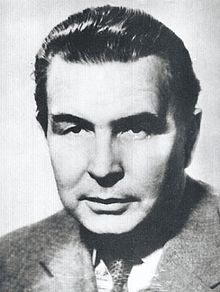| Revision as of 00:21, 18 September 2008 editLightbot (talk | contribs)791,863 edits Units/dates/other← Previous edit | Revision as of 17:12, 8 November 2008 edit undo88.132.30.97 (talk) →Further readingNext edit → | ||
| Line 17: | Line 17: | ||
| ==Further reading== | ==Further reading== | ||
| *Ozinga, James R., ''The Rapacki Plan: the 1957 Proposal to Denuclearize Central Europe, and an Analysis of Its Rejection,'' Jefferson, NC, McFarland & Co, 1989, ISBN 0-89950-445-0. | *Ozinga, James R., ''The Rapacki Plan: the 1957 Proposal to Denuclearize Central Europe, and an Analysis of Its Rejection,'' Jefferson, NC, McFarland & Co, 1989, ISBN 0-89950-445-0. | ||
| Historical study about the Rapacki-Plan: | |||
| * | |||
| {{Ministers of Foreign Affairs of Poland}} | {{Ministers of Foreign Affairs of Poland}} | ||
Revision as of 17:12, 8 November 2008

Adam Rapacki (December 24, 1909–October 10, 1970) was a Polish politician and diplomat.
Life
Rapacki was born in Lwów, Ukraine in 1909. He was a member of the Polish Socialist Party from 1945 to 1948 as well as its successor, the Polish United Workers' Party. He was also a member of the Politburo of the Central Committee up until 1968, onboard as the Minister of Seafaring and the Minister of Higher Education and Research.
From 1956 to 1968, he was the Foreign Minister in the cabinet of Józef Cyrankiewicz. On October 2, 1957, he presented at the United Nations his plan for a nuclear-free zone in Central Europe (comprising Czechoslovakia, Poland, East and West Germany) — known as the "Rapacki Plan".
Rapacki died in Warsaw, Poland in 1970.
See also
External links
- Nuclear-Weapon-Free Zones (NWFZ) At a Glance, Arms Control Association, July 2003.
Further reading
- Ozinga, James R., The Rapacki Plan: the 1957 Proposal to Denuclearize Central Europe, and an Analysis of Its Rejection, Jefferson, NC, McFarland & Co, 1989, ISBN 0-89950-445-0.
Historical study about the Rapacki-Plan:
This biographical article about a Polish politician is a stub. You can help Misplaced Pages by expanding it. |